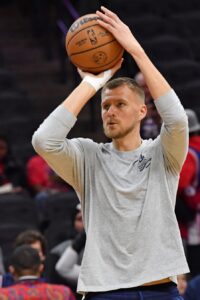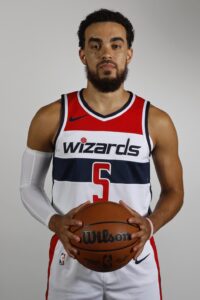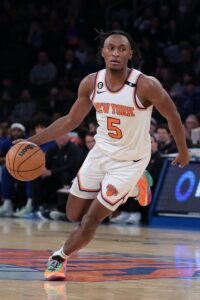This is the first entry in our series breaking down the significant trades of the 2023 offseason. As opposed to giving out grades, this series explores why the teams were motivated to make the moves. Let’s dive into a three-team blockbuster between the Celtics, Grizzlies and Wizards…
On June 23:
- The Celtics acquired Kristaps Porzingis, the draft rights to Marcus Sasser (No. 25 pick; from Memphis), and the Warriors’ 2024 first-round pick (top-four protected; also from Memphis).
- The Grizzlies acquired Marcus Smart.
- The Wizards acquired Tyus Jones, Danilo Gallinari, Mike Muscala, and the draft rights to Julian Phillips (No. 35 pick; from Boston).
- Note: The Wizards generated a $12,354,400 traded player exception as part of this deal, which is currently the fourth-largest TPE in the NBA.
The Celtics’ perspective:

Dealing away one of the longest-tenured players in the league, an accomplished veteran who won Defensive Player of the Year just two seasons ago, certainly wasn’t an easy decision for Boston. It’s pretty clear that moving Smart wasn’t the team’s top priority, as an earlier version of this trade involved Malcolm Brogdon instead, but it was reportedly scuttled because the Clippers didn’t have time to evaluate the Sixth Man of the Year’s elbow (Brogdon was later flipped to Portland in the Jrue Holiday blockbuster).
Smart has long been considered the heart of the Celtics due to his consistent effort, energy and intensity. Who will fill his leadership void? They’re hoping that Jayson Tatum and Jaylen Brown step up to the plate; we’ll see how that plays out.
That’s not to say Smart is without flaws. He has never been an efficient scorer, and has had an unfortunate penchant for forcing out-of-rhythm shots at the end of games throughout his career.
While he wasn’t directly involved in this transaction, you could easily argue that later moving off Grant Williams was a financial byproduct of the deal. The Celtics added a little over $7MM to their salary cap figure (and far more to their luxury tax bill) by trading for Porzingis, which made going further into the tax to pay Williams less palatable.
It’s worth noting that this trade framework would not have been possible for the Celtics if Porzingis had declined his option and entered free agency. The deal was made in June, when the old CBA was in effect — it was more lenient for teams above the first tax apron.
If the Celtics had tried to do a sign-and-trade for Porzingis a couple weeks later, they would have been required to add more money for salary-matching purposes, and that could have been a deal-breaker for Washington (Boston also would have been hard-capped in that scenario, another significant obstacle).
Gallinari never suited up for Boston after tearing his ACL last year, and Muscala was a trade deadline acquisition who wasn’t in the team’s postseason rotation. Given their advancing ages (Gallinari is 35; Muscala 32) and defensive limitations, neither were likely to be around beyond this season.
Porzingis, on the other hand, just turned 28 and is coming off a career year in which he averaged 23.2 PPG, 8.4 RPG, 2.7 APG and 1.5 BPG on .498/.385/.851 shooting in 65 games (32.6 MPG). He’s theoretically entering his prime. The Celtics have never had a frontcourt player who can score like the 7’3″ big man during the Tatum/Brown era.
Porzingis’ size, timing and willingness to contest shots makes him a formidable rim protector defensively, but he’s not particularly agile and isn’t a great rebounder. Asking him to patrol the perimeter doesn’t play to his strengths on that end, but he can make a real impact roaming and in the paint.
Offensively, Porzingis is an incredibly difficult cover if he’s hot on a given day, because he can simply shoot over the grand majority of players. He has deep range from beyond the arc and can score from all over the court, and is good at leveraging the threat of his shooting to drive and draw fouls. He has to be accounted for at all times.
Actually getting Porzingis the ball to maximize his impact on that end might be an issue. With Tatum, Brown, Porzingis and now Holiday in the mix, the Celtics have a lot of players who like to shoot. It will be interesting to see how the team’s shot distribution shakes out.
Porzingis picked up his $36MM player option as part of the deal, and the Celtics later signed him to a two-year, $60MM extension, seemingly making him a franchise cornerstone for the next three years.
Boston also received the draft rights to Marcus Sasser (the No. 25 pick) and Golden State’s 2024 first-rounder (top-four protected) from Memphis, while sending Julian Phillips (the No. 35 pick) to Washington (Phillips was later flipped to Chicago). The Celtics made multiple draft-night deals and accumulated several future second-round picks, ultimately sending Sasser to Detroit while selecting Jordan Walsh.
That Warriors pick has some upside, but the 2024 draft class is considered pretty weak right now. Golden State’s core is aging and Stephen Curry has missed a significant amount of time over the past handful of seasons – depending on health, there’s a chance it could be a lottery pick, though it could also end up being a late first-rounder if everything goes right for the Warriors.
Instead of keeping the pick, the Celtics used it as part of the package for Holiday, doubling down on their aggressive offseason overhaul by once again sacrificing depth for top-end talent.
The Porzingis trade carries a good deal of risk for Boston. That risk comes in multiple forms.
For starters, Porzingis has been injury prone over the course of his career, making him an inherently high-risk, high-reward player. He was held out of the World Cup for Lativa due to plantar fasciitis in his right foot, which was concerning, but he says he’s “totally fine” now.
Porzingis’ lengthy injury history ties into Boston’s depth, or lack thereof. Boston’s six-man group of Derrick White, Holiday, Brown, Tatum, Porzingis and Al Horford has as much two-way talent as any team in the league. But Horford is 37 years old, and there are major question marks beyond those six players.
Still, it’s not like the Celtics are any different in that regard than the Bucks, Nuggets and other contenders who have elite top-end talent but shaky depth. And if Boston is healthy entering the playoffs, it will be on a very short list of favorites for its 18th NBA title.
The other primary risk of the deal is that the Celtics added a lot of salary – both now and in the future – by trading for and then extending Porzingis. Their financial commitments will only grow over time, as Brown received a super-max extension that will kick in starting in 2024/25, while Tatum will likely receive his own super-max deal next summer (that will begin in ‘25/26). Holiday is also up for a new deal; he could be a free agent in 2024 if he declines his player option.
Most teams decided to shed long-term salaries this offseason in an effort to avoid the punitive second tax apron. The Celtics obviously felt that adding Porzingis (and later Holiday) to a talented roster increased their championship odds, a gamble deemed necessary after losing in the NBA Finals in ‘21/22 and falling in the Eastern Conference Finals last season.
The Grizzlies’ perspective:
 Initially, I was surprised that the Grizzlies were willing to give up a fairly strong haul of assets to acquire Smart. But the more I thought about it, the more it made sense.
Initially, I was surprised that the Grizzlies were willing to give up a fairly strong haul of assets to acquire Smart. But the more I thought about it, the more it made sense.
Jones has been a valuable role player for Memphis over the past four seasons. He’s historically great at taking care of the basketball, having led the league in assist-to-turnover ratio each of the past five seasons. His steady presence was a nice complement to Ja Morant’s risk-taking play-style.
However, he’s on an expiring $14MM contract, while Smart won’t become a free agent until 2026 — he’ll earn $60.6MM over the next three years. Having long-term team control is important for small market franchises like the Grizzlies, as they aren’t a free agent (or trade request) destination.
There’s no question that Smart is a direct upgrade over Jones defensively. He’s bigger, stronger and much more versatile – capable of switching across four positions. Jones is solid at defending smaller guards, but lacks the size and strength to defend up the positional spectrum.
That versatility should allow Smart to play alongside Morant more comfortably than Jones could. It was a nice change of pace offensively to have Morant off the ball at times, but it made Memphis far more exploitable on the other end when Morant and Jones were on the court together.
Smart is also better at creating his own shot on offense than Jones, and is a quality play-maker in his own right, even if his shooting is extremely streaky from game to game.
One of the best attributes that Smart will bring to Memphis is his leadership and willingness to hold teammates accountable. Given Morant’s well-documented off-court troubles over the past year-plus, adding a vocal veteran leader like Smart makes a lot of sense. That’s not to say Jones isn’t a leader in his own right, but the Grizzlies clearly needed to shake things up after a disappointing playoff run saw them lose to the Lakers in the first round.
Late first-round picks like Sasser are a crapshoot – they can be hidden gems, or out of the league after a few years. The Grizzlies have plenty of youth on their roster, so consolidating some of their assets for a proven veteran was a logical choice.
As discussed above, the Warriors pick the Grizzlies sent out does have some upside value, but the 2024 draft currently isn’t viewed favorably, and Memphis still controls all of its own future first-round picks. This trade won’t prevent the Grizzlies from making a major all-in move down the line, if they choose to go that route.
Another angle to consider is Jones may have wanted — or at least been open to — a change of scenery. Despite being one of the top backups in the league, his earning potential would always have been limited in Memphis playing behind Morant. The star guard’s 25-game suspension doesn’t change that.
Jones will have an opportunity for a bigger role in Washington, and the Grizzlies may have increased their championship odds by adding Smart, who has won a ton of games over the years and been a part of several deep playoff runs with the Celtics.
The Wizards’ perspective:
 A career backup, a couple of big men who can shoot but have major defensive limitations, a second-round pick, and a mid-sized traded player exception for a borderline All-Star? That’s all the Wizards could get for Porzingis?
A career backup, a couple of big men who can shoot but have major defensive limitations, a second-round pick, and a mid-sized traded player exception for a borderline All-Star? That’s all the Wizards could get for Porzingis?
That’s one (rather shortsighted) way to look at this trade. The other is Washington’s new front office simply got what it could, when it could for a player who was facing an imminent decision on his $36MM option. Had Porzingis declined his option and entered unrestricted free agency, he could have left the Wizards with nothing in return.
The Wizards picked up a proven point guard in Jones who should be a nice offensive complement alongside another new addition in Jordan Poole. One of Poole’s biggest weaknesses is turning the ball over, which is Jones’ greatest strength.
You could argue that acquiring Jones while later moving off Monte Morris — a player on a cheaper contract with similar strengths and weaknesses – doesn’t make much sense. However, the Wizards did receive a future second-round pick for Morris, and Jones has higher upside as a play-maker, even if his shot hasn’t been as consistent.
Since Jones, Gallinari and Muscala are all on expiring contracts, it’s certainly possible that all three players could be on the move before the February trade deadline. The Wizards are in the early stages of retooling their roster after dealing away Porzingis and Bradley Beal; continuing to accumulate assets is the most prudent course of action. If they can get positive returns, they might take them.
If Jones has a big year, maybe that means they re-sign him and trade him down the line. Maybe they just keep him for a few years – he’s only 27. There’s plenty of flexibility to work with there, which is valuable when the roster isn’t close to contention.
It’s hard to envision Gallinari having much value at his age and coming off a major injury, even if he’s had a long and very productive career. Still, maybe someone will bite and give up a second-rounder or two if he shows he’s healthy after a second ACL tear.
As for Muscala, he showed last season he could have positive trade value – the Celtics gave up a couple second-round picks to land him from OKC. His $3.5MM contract is the most affordable of the three players, which makes matching salaries easier as well, especially for the league’s top spenders.
By almost every metric, Porzingis was Washington’s best player last season. But the Wizards have been mired in mediocrity for years, and the old roster wasn’t going anywhere. The new front office had to make changes. They decided to accommodate Porzingis’ desire to go to Boston and tried to extract as much value for him as they could, given their limited leverage.

 The deadline for a player to sign a rookie scale extension is Monday, October 23 at 5:00 pm Central time.
The deadline for a player to sign a rookie scale extension is Monday, October 23 at 5:00 pm Central time.